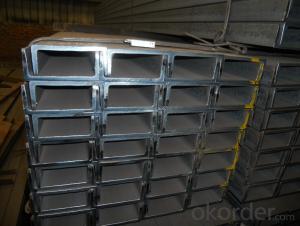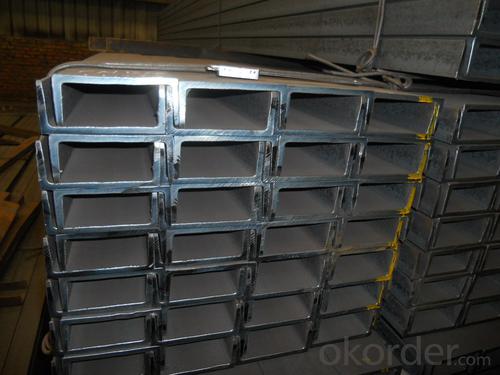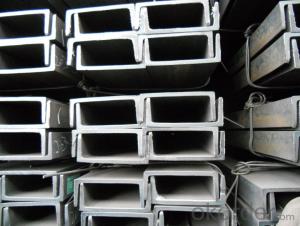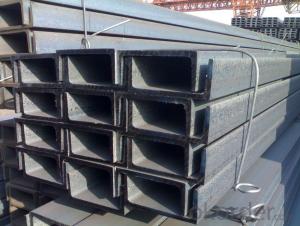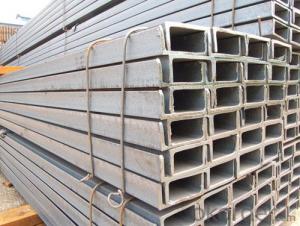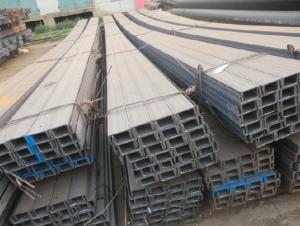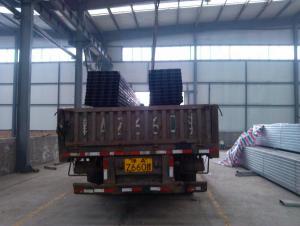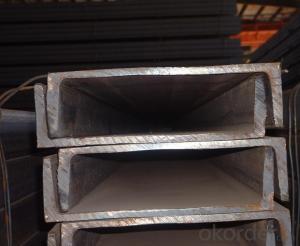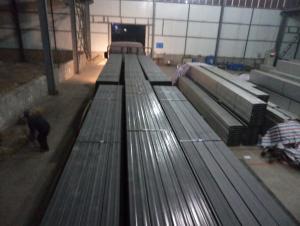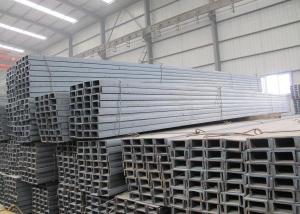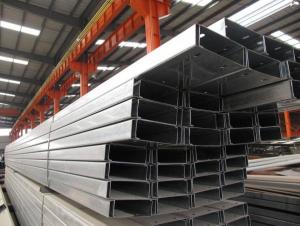Steel Channel 100-125mm
- Loading Port:
- China Main Port
- Payment Terms:
- TT OR LC
- Min Order Qty:
- -
- Supply Capability:
- -
OKorder Service Pledge
OKorder Financial Service
You Might Also Like
Specifications of JIS Channel Steel:
1. We are definitely speciallizing in manufacturing and supplying channel steel as per japanese standard, which is characterised with high mechanical strength and competitive prices.
| Standard | JIS G3192 |
| Material Grade | SS400 |
| Sizes | 50mm to 200mm |
| Sales Volume/Year | 3000MT |
| Destination Area | Middle East, Africa, Southeast Asia |
Size and Mass:
| Size (mm) | Mass (Kg/m) | Size (mm) | Mass (Kg/m) |
| 100*50*3.8 | 7.30 | 100*50*5.0 | 9.36 |
| 100*50*4.5 | 8.97 | 125*65*5.2 | 11.66 |
The mechanical property of JIS Channel Steel:
Grade | Yield Strength,N/mm² | Extension Strength N/mm² | |||
Thickness of Steel,mm | |||||
≦16 | >16-≦40 | >40-≦100 | >100 | ||
SS400 | ≧245 | ≧235 | ≧215 | ≧205 | 400-510 |
Package & Delivery of JIS Channel Steel:
1.The channel steel will be packed in bundle with steel wire at each end of every bundle and color marking in order to help the customer to recognize his goods more easily at sight.
2. And the channel steel could be loaded into 20ft or 40ft container, or by bulk cargo.If the weight of each bundle reaches more than 3.5 mt, the loading by break bulk cargo should be choosed.When the weight of each bundle reaches less than 3mt, the loading by container should be choosed.
3.As for the transportaion from mill to loading port, the truck will be usually used. And the maximum quantity for each truck is 40mt.
4.All in all, we could do in accordance with customer's request.
*If you would like to get our price, please inform us the size, standard/material and quantity. Thank you very much for your attention.
- Q: Can steel channels be used for railway track support?
- Indeed, railway track support can make use of steel channels. These channels are frequently employed as a cost-efficient and long-lasting structural support component in a variety of applications, including railway track support. They offer robustness, stability, and the ability to bear heavy loads, rendering them suitable for sustaining the weight and forces imposed by trains on railway tracks. Easy fabrication and installation are possible with steel channels, and they possess the capability to endure harsh environmental conditions and substantial loads. Furthermore, their innate resistance to corrosion establishes them as a dependable option for long-term employment in railway track support systems.
- Q: Can steel channels be welded together?
- Yes, steel channels can be welded together. Welding is a common method used to join steel channels to create larger structures or reinforce existing ones.
- Q: How do steel channels contribute to the overall daylighting of a building?
- Steel channels do not directly contribute to the overall daylighting of a building. Steel channels are structural components used in construction, specifically in framing and support systems. However, the overall daylighting of a building is determined by the design and placement of windows, skylights, and other transparent or translucent elements that allow natural light to enter the space.
- Q: What are the different design codes for steel channels?
- There are several design codes that are commonly used for steel channels, including the American Institute of Steel Construction (AISC) Specification for Structural Steel Buildings, Eurocode, British Standards, and Canadian Standards. These codes provide guidelines and requirements for the design and construction of steel channels to ensure structural integrity and safety.
- Q: How do steel channels contribute to the overall strength of a structure?
- There are multiple ways in which steel channels contribute to the overall strength of a structure. To begin with, they offer structural support and stability by evenly distributing the load across the structure. The shape of steel channels, which includes a wide base and tapered edges, allows them to bear more weight and resist bending or buckling when faced with heavy loads. Moreover, steel channels enhance the rigidity of a structure by preventing lateral movement or twisting. They function as beams, establishing a framework that combats deformation and ensures the structure maintains its shape and integrity, even under challenging circumstances like earthquakes or strong winds. Furthermore, steel channels can be strategically positioned in crucial areas of a structure, such as load-bearing walls or columns, to reinforce these vulnerable points. This reinforcement significantly increases the overall strength and durability of the structure, reducing the risk of structural failure. In addition, steel channels possess high tensile strength, enabling them to withstand stretching or elongation when subjected to tension. This property is particularly important for structures that encounter dynamic loads, like bridges or tall buildings. Steel channels play a role in distributing and absorbing these dynamic forces, preventing excessive deflection or deformation that could jeopardize the stability of the structure. In conclusion, the contribution of steel channels to the overall strength of a structure is significant. They provide structural support, enhance rigidity, reinforce vulnerable points, and offer high tensile strength. Their ability to distribute loads, resist bending or buckling, and withstand dynamic forces makes them an essential component of any robust and long-lasting structure.
- Q: How many pieces of channel steel?
- The raw material steel billet for channel steel is carbon or low alloy steel billets with a carbon content of not more than 0.25%. The finished channel steel is delivered by hot forming, normalizing or hot rolling. The specifications are shown in terms of waist height (H) * leg width (b) * and waist thickness (d) mm.
- Q: Are steel channels available in different finishes?
- There are various finishes available for steel channels. Different methods can be used to finish steel channels, including galvanization, powder coating, painting, or leaving them untreated. Galvanization involves applying zinc to the steel to prevent corrosion and create a shiny metallic finish. Powder coating, on the other hand, involves applying a dry powder to the steel and baking it for a durable and appealing finish. Painting is a common finish where a layer of paint is added to the steel channels for protection and aesthetic enhancement. Alternatively, steel channels can be left untreated for a natural, raw look. The availability of different finishes allows customers to choose the most suitable option based on their specific requirements for protection, appearance, and functionality.
- Q: Can steel channels be used for building facades?
- Yes, steel channels can be used for building facades. They are commonly used due to their strength, durability, and versatility in design. Steel channels provide structural support and can be attached to the building frame to create a framework for the facade. They can also be used to hold and secure other facade materials such as glass, metal panels, or cladding.
- Q: What are the different methods for cutting steel channels?
- There are several methods for cutting steel channels, including manual methods such as hacksaw or chisel, power tools like angle grinders or reciprocating saws, and more advanced methods like plasma cutting or water jet cutting. The choice of method depends on factors such as the thickness and type of steel, desired precision, and available equipment.
- Q: How do steel channels contribute to building envelope performance?
- There are several ways in which steel channels contribute to the performance of building envelopes. To begin with, steel channels are commonly used as framing elements in the construction of building envelopes. These channels serve to provide structural support and distribute loads, ensuring that the building remains stable and intact. This is particularly important in regions with strong winds or seismic activity, where the building envelope must be able to withstand external forces. Furthermore, steel channels can be utilized to establish a continuous air barrier within the building envelope. By effectively sealing and insulating the channels, air leakage can be minimized, resulting in reduced energy loss and improved energy efficiency for the building. This is of paramount importance in terms of thermal comfort and the reduction of heating and cooling expenses. Moreover, steel channels can be incorporated into the building envelope as part of a rainscreen system. Rainscreens are designed to manage moisture and prevent water infiltration, while still allowing for proper ventilation. By utilizing steel channels as support for cladding materials, such as metal panels or glass, a protective barrier against the elements can be created. Finally, steel channels offer a great deal of design flexibility and versatility. They can be easily customized and installed in various configurations to meet specific design requirements and aesthetic preferences. This enables architects and designers to create visually appealing building envelopes while still maintaining performance and durability. In summary, steel channels play a vital role in enhancing the performance of building envelopes by providing structural support, establishing air barriers, managing moisture, improving energy efficiency, and offering design flexibility.
Send your message to us
Steel Channel 100-125mm
- Loading Port:
- China Main Port
- Payment Terms:
- TT OR LC
- Min Order Qty:
- -
- Supply Capability:
- -
OKorder Service Pledge
OKorder Financial Service
Similar products
Hot products
Hot Searches
Related keywords
